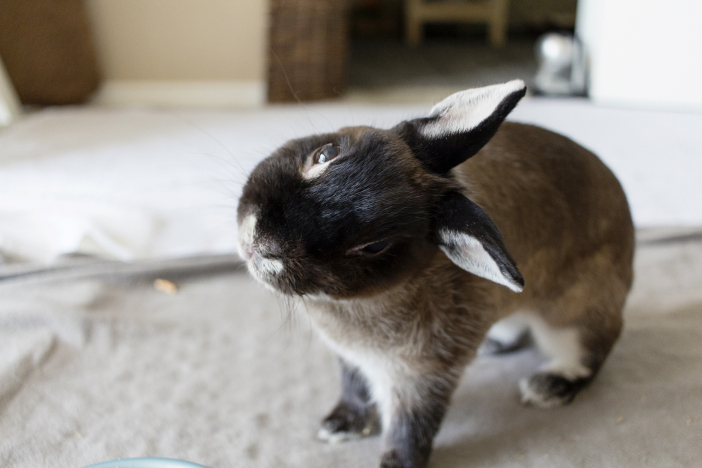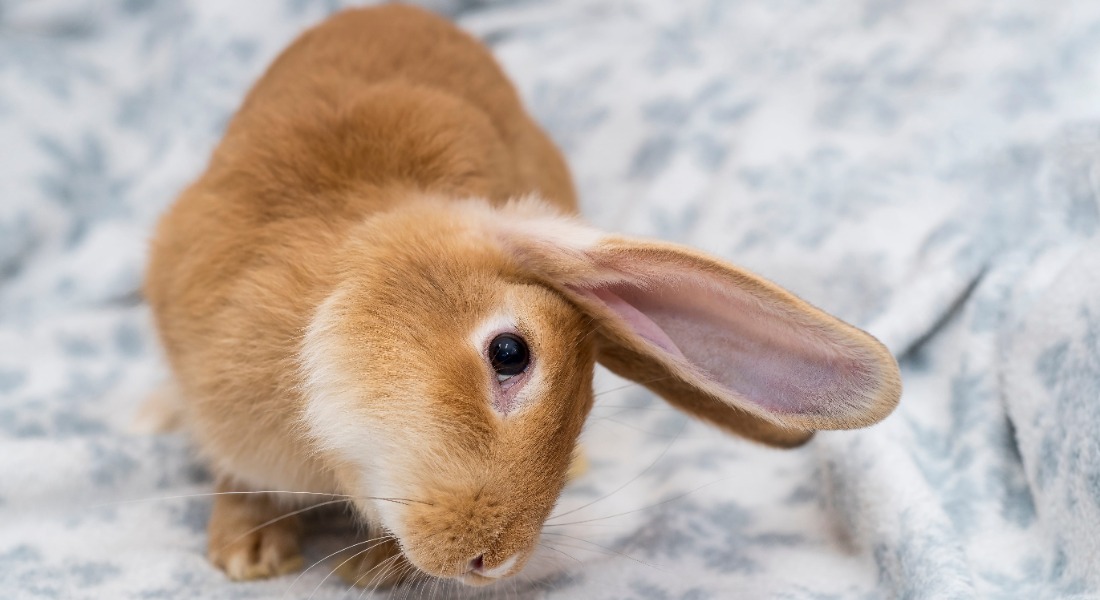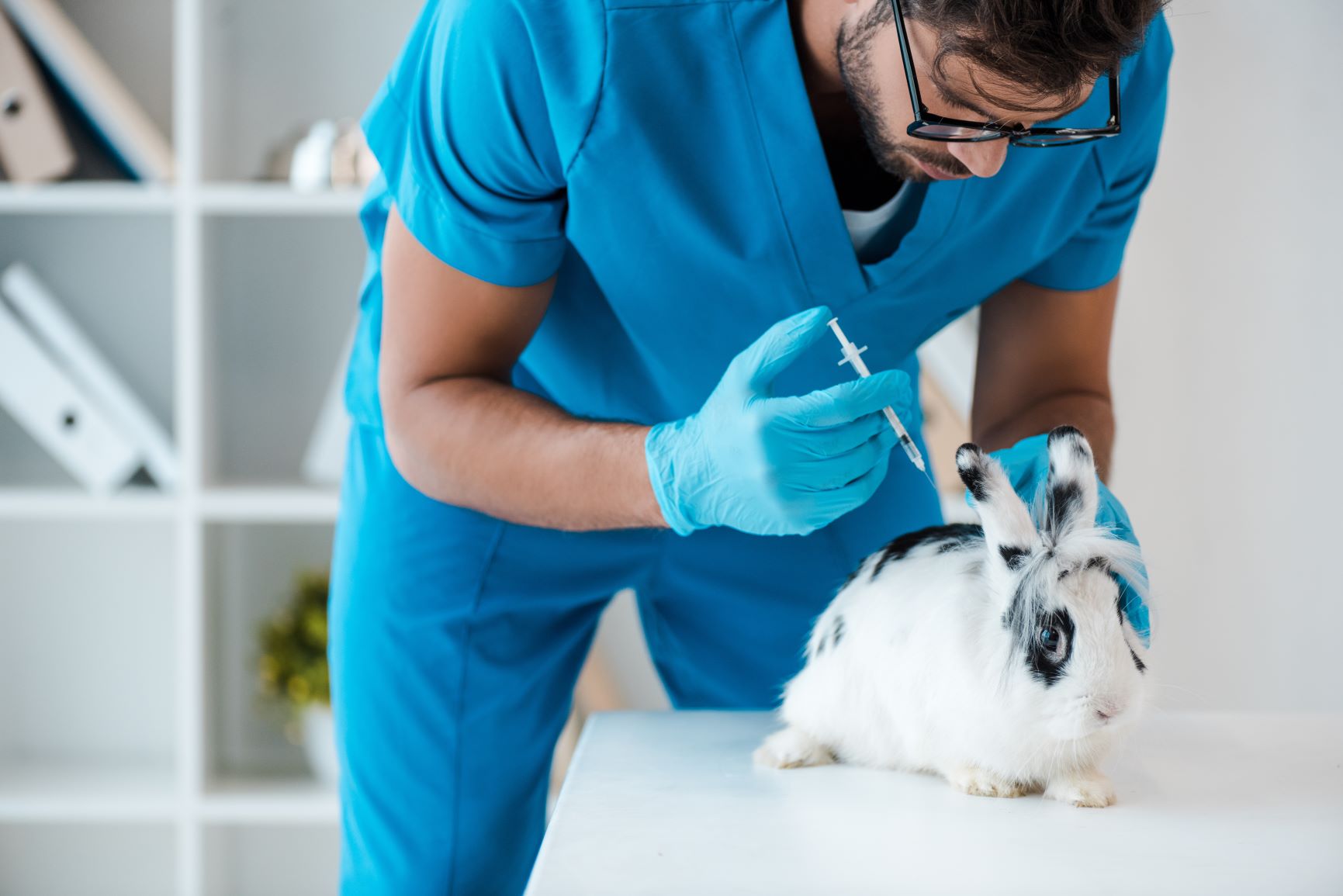What are Parasitic Diseases?
A parasitic disease is a disease caused by a parasitic organism (Rogers, 2020). There are two types of parasitic organisms that affect animals; Helminths and Ectoparasites (Kinman, 2018). Helminths are worms that feed on and in an animals body, examples include roundworm (Mandal, 2019). Ectoparasites feed on a hosts skin and includes ticks and fleas (Afzal et al., 2021).
What are Infectious Diseases?
An infectious disease negatively affects an individuals health (Feigin & Garg, 2022). They are caused by a pathogenic organism, and can be spread via direct transmission from an infected individual or a contaminated inanimate object (Hochberg & Van Seventeen, 2017). Examples of infectious diseases include Kennel Cough in dogs and Myxomatosis in Rabbits.

Preventative Treatments for
Man’s (and Woman’s!) Best Friend
(Pinker, 2020)
Parasitic Diseases
Fleas
Fleas are small, bloodsucking, wingless ectoparasites that are carriers of disease (Traub & Rothschild, 2022). The bite of a flea causes an allergic reaction, causing your dog to scratch due to itchiness (Pagán, 2021). Fleas should be dealt with as soon as possible, to reduce the risk of your dog contracting a disease from them, including Tapeworm, Flea-bite Anaemia (Kramer, 2016) and Bartonellosis (Wag, 2020).

Treating Fleas
It is better to prevent fleas than to treat them. The use of oral and topical flea treatments can be used to not only prevent but to treat flea infestations. The treatment should be applied as soon as possible, to minimise the chances of flea-related illnesses arising (RSPCA, n.d.).

Treatment of the house environment for fleas is advised so they do not return. Cleaning dog beds regularly and vacuuming of the house will help keep the fleas at bay (Gamble, n.d.).


How does my dog get fleas?
Fleas thrive in high grass, sand and shrubbery (Fantastic Pest Control, 2022). Fleas enjoy hitchhiking on our clothes which can then be brought into the home and introduced to our pet. They are also excellent jumpers and can jump from one dog to another, such as when they are playing with a flea infested dog (Mitchell, 2022).
Preventing Fleas
Oral and topical flea treatments can be used to prevent fleas in dogs (Murphy, 2018). Topical flea treatments are placed on the back of the dogs neck, with the fur parted and a drop of treatment applied to the area (Colegrave, n.d.). Topical treatments often include the active ingredients Fipronol (e.g.., Frontline Spot-on) and Imidacloprid (e.g., Advantage). These ingredients attacks the nervous system of the flea, ultimately paralysing and killing them (Murphy, 2018).
Oral flea treatments come as a pill or tablet. Oral flea treatments contain Isoxazoline chemicals to ward off fleas (Kerns, 2019). Fluralaner and afoxolaner, are commonly used in oral treatments (Malmanger, 2020). Fluraner is a potent insecticide and acaricide (Gaens, 2019) and is used in chewable tablets for both flea and tick control, attacking their nervous system (Burgess et al., 2020). Likewise, Afoxolaner attacks both flea and ticks, yet has to be given more regularly than that of Fluraner based flea treatments (Walden, 2016b).

Infectious Diseases
Kennel Cough
Kennel Cough is a very common respiratory disease caused by Bordetella Bronchiseptica and Canine Parainfluenza (Hickling, 2022). Symptoms include hacking cough, nasal discharge and fever-like signs (Walden, 2016a). The disease is spread by respiratory droplets from infected dogs, even dogs that are asymptomatic can spread the disease (Walden, 2019).

Treating Kennel Cough
The vaccine for kennel cough doesn’t give 100% protection against the illness. Yet, it does adequately reduce the chances of catching and experiencing harsh symptoms of kennel cough (PDSA, 2020a). A dog with kennel cough should recover within 3 weeks without any veterinary intervention (Playforth, 2021). It is advised to aid recovery that dogs get plenty of rest, avoid the use of collars to eliminate pulling on their throat, and ensure that their environment is highly ventilated (Waterworth, 2021).


Preventing Kennel Cough
Kennel Cough can be prevented by the Bordetella bronchiseptica vaccine. The vaccine can be given to a puppy at as young as 3 weeks old! (Blue Cross, 2021). Live strains of 92b or B-C2 are most commonly used active ingredients within the kennel cough vaccine. (Veterinary Medicines Directorate, 2018). The vaccination is delivered nasally as drops, yet despite this vaccine not being core, it is highly recommended for multi-dog households and dogs that come into contact with other dogs frequently (Stregowski, 2021). The vaccines deliver a live, but weakened, bordetella antigens into the body, initiating an immune response (WHO, 2020). The Bordetella bronchiseptica vaccine should be administered every 12 months so that they are kept up to date (PDSA, 2020).


Preventative Treatments for your Rabbit
(Richardson, 2022)
Parasitic Diseases
E. Cuniculi
E. Cuniculi is a multisporidial parasite that causes both central nervous system and renal disease in rabbits (Bradley et al., 2019). Over 50% of the pet rabbit population in the UK are exposed to e. cuniculi (Shackleton, 2017). Common signs of E. Cuniculi includes head tilt, cloudy eyes (Wright, 2014) nystagmus, ataxia and paresis (Mancinelli, 2015). The disease can be spread through urinary spores, which can then be eaten by rabbits through contaminated water or food (Vets Now, 2020). Baby rabbits, i.e. kits, can be inutero infected in the womb of an infected mother (Axelson & Rich, n.d.).

Treating E. Cuniculi
Treating E. Cuniculi is largely focused on stopping spore creation and eradicating inflammation (Shackleton, 2017). Fenbendazole is a broad-spectrum anti-parasitic drug, which treats a variety of helminths, i.e. parasitic worms (Fitzgerald & Newquist, 2013; Papich, 2016). It is a benzimidazole based drug, which is used in a variety of anti-parasitic drugs (Kamanna, 2019). The drug is given orally via a syringe directly (Meridian Veterinary Practice, 2013). Fenbendazole kills the parasites by binding to tublin, a type of protein, interfering with the E. Cuniculi to produce energy and ultimately killing the parasite (Burke, 2017; Van Gels, 2022).

Fenbendazole slows and or halts the multiplication of E. Cuniculi within rabbits, and the treatment should be carried out for at least 28 days (Clark, 2020).

Preventing E. Cuniculi
Fenbendazole is recommended to be given to a new rabbit for 4 weeks orally after being brought home (Richardson, n.d.). E. Cuniculi cannot be fully prevented, as the parasite is found within the environment and in wild rabbits (PDSA, n.d.).

Although Fenbendazole is used primarily for the treatment of rather than the prevention of E. Cuniculi, it should be given to individuals more predisposed as a precautionary measure (Magalhaes et al., 2022). All juvenile rabbits, also known as a kit, should be routinely treated, as well as infected individuals (Yeates, 2019). If they do have the E. Cuniculi virus, the fenbendazole will destroy the pathogen and stop it from causing further internal damage. Luckily, if they do not have the disease, the medication has no side effects yet still keeps them protected (RVC, n.d.).
E. Cuniculi spores stay within the environment at 72°f/22°c for up to 7 weeks and over a few months in humid areas (Agognon et al., 2021). The rabbits environment should be cleaned regularly, to ensure the spread of E. Cuniculi through contaminated food, water or environment (Prime, 2022). The environment should be cleaned with 0.1% bleach or 70% ethanol for a 1 minute contact time to kill E. Cuniculi in the environment (Noonan, 2017).
Infectious Diseases

Preventing Myxomatosis
It is highly recommended that your rabbit should be vaccinated against Myxomatosis at as young as 7 weeks old (Speight, 2020). This vaccination both protects your rabbit from Myxomatosis and Viral Haemorrhagic Disease, also known as VHD, another highly contagious and fatal disease (Faraday, 2021). Small amounts of weakened myxomatosis virus are introduced into the rabbits body, and then their immune system will recognises the virus and create antibodies to fight it, so immunity is gained (European Medicines Agency, 2019).
Rabbits that are kept outdoors and are exposed to wild rabbits are more likely to contract the virus (Varga, 2014). Ensuring there is no areas of stagnant water present in your garden means vectors will be less attracted to the area (Blue Cross, 2022). Outdoor rabbit hutches should have bug-proof guards to ensure no vector of myxomatosis can enter and affect the rabbit (PDSA, 2022b). If you also have dogs and cats, ensuring they are up to date on their worming treatment will ensure they can not be spread to your rabbit (RWAF, 2020).

Treating Myxomatosis
Unfortunately there is no specified treatment for the myxomatosis virus. Intensive treatment of the virus gives the rabbit the best chance of survival, despite the recovery chances being slim to none (Faulkner, 2022), fatally rates of myxomatosis are as high as 99% (DeMello, 2022). Intensive treatment will regularly involve fluid therapy, anti-inflammatories for swelling, antibiotics for secondary infections and ensuring a warm environment (Riley, 2020; Vet Help Direct, 2020). Environmental temperature should be around 84°f or 28°c. Despite a veterinarians and owners greatest efforts to treat a rabbit with myxomatosis, they are rarely triumphant (Riley, 2020).
Myxomatosis
Myxomatosis is a serious, and rapidly fatal, viral disease (McLeod, 2022). It is rapidly spread via blood sucking parasites, including fleas, mosquitos and ticks (Blue Cross, 2022).
Clinical signs of a rabbit with myxomatosis include:
- Discharge from the eyes
- Lethargy
- Inappetance
- Fluid around eyes, ears, mouth and nose
- Respiratory stress
(Dinev, 2012; Playforth, 2020)

Multi-Rabbit Households
If myxomatosis is contracted by one of your rabbits in your herd, isolate them immediately! (Silva, n.d.). Any new additions to a rabbit colony should be isolated for at least 3 weeks before introducing them, ensuring the new rabbit is healthy and not infectious with a disease (PDSA, 2020b).

1395 words
References
1st Pet Veterinary Centers. (2021, November). 4 Health Problems Fleas Can Create for Your Dog. 1st Pet Veterinary Centers. https://1stpetvet.com/4-health-problems-fleas-can-create-for-your-dog/
Afzal, M.S., Ahmed, H., Awan, U.A., Bashir, R., Cao, J., Khan, M.R., Mahmood, M., & Muhammad, A. (2021). Epidemiology of ectoparasites (ticks, lice, and mites) in the livestock of Pakistan: A Review. Frontiers in Veterinary Science, 8. https://doi.org/10.3389/fvets.2021.780738
Animal Clinic of Woodruff. (2017, August). Do I Need to Vaccinate my Dog for Kennel Cough?. Animal Clinic of Woodruff. https://www.animalclinicofwoodruff.com/pet-blog/vaccinations/do-i-need-to-vaccinate-my-dog-for-kennel-cough
Axelson, R., & Rich, G. (n.d.). Encephalitozoonosis in Rabbits. VCA Animal Hospitals. Retrieved November 16, 2022 from https://vcahospitals.com/know-your-pet/encephalitozoonosis-in-rabbits
Blue Cross. (2021, December). Kennel Cough. Blue Cross. Retrieved November 16, 2022 from https://www.bluecross.org.uk/advice/dog/kennel-cough
Blue Cross. (2022, September). Myxomatosis. Blue Cross. Retrieved November 23, 2022 from https://www.bluecross.org.uk/advice/rabbit/health-and-injuries/myxomatosis
Bradley, C.W., Latney, L.V., & Wyre, N.R. (2019). Encephalitozoon cuniculi in pet rabbits: diagnosis and optimal management. Vet Med (Auckl), 5, 169-180. https://doi.org/10.2147/VMRR.S49842
Bunnyhub (2020, September). How to prevent your rabbit from getting myxomatosis. Bunnyhub. https://www.bunnyhub.org/how-to-prevent-your-rabbit-from-getting-myxomatosis/
Burgess, E.R., Geden, C.J., Lohmeyer, K.H., King, B.H., Machtinger, E.T., & Scott, J.G. (2020). Toxicity of fluralaner, a companion animal insecticide, relative to industry-leading agricultural insecticides against resistant and susceptible strains of filth flies. Scientific Reports, 11166. https://doi.org/10.1038/s41598-020-68121-z
Burke, A. (2017a). Panacur For Dogs. American Kennel Club. https://www.akc.org/expert-advice/health/panacur-for-dogs/
Charlton, S. (2022, July). Can I walk my dog with kennel cough?. Barc London. https://www.barclondon.com/blogs/mindfulness-wellbeing/can-i-walk-dog-with-kennel-cough
Clark, C. (2020, September). Rabbit Health: E. Cuniculi. Pet Education and Training Behaviour Services. https://www.peteducationandtraining.co.uk/articles/rabbit/rabbit-health-e-cuniculi/
DeMello, M. (2022, July). Myxomatosis. House Rabbit Society. Retrieved November 23, 2022 from https://rabbit.org/myxo/
Dinev, I.V. (2012). An outbreak of myxomatosis in rabbits in Bulgaria clinicomorphological studies. Trakia Journal of Sciences, 10(1), 79-84. http://www.uni-sz.bg/tsj/Vol.10,%20N%201,%202012/Iv.Dinev.pdf
Dogra, N., Kumar, A., & Mukhopadhyay, T. (2018). Fenbendazole acts as a moderate microtubule destabilizing agent and causes cancer cell death by modulating multiple cellular pathways. Scientific Reports, 8. https://doi.org/10.1038/s41598-018-30158-6
European Medicines Agency. (2019, December). Nobivc Myxo-RHD Plus. European Medicines Agency. Retrieved November 23, 2022 from https://www.ema.europa.eu/en/medicines/veterinary/EPAR/nobivac-myxo-rhd-plus
Fantastic Pest Control (2022, August). Fleas – Facts and Identification. Fantastic Pest Control. https://www.fantasticpestcontrol.co.uk/fleas/
Faraday, J. (2021, April). Your pet Rabbit and Viral Haemorrhagic Disease (VHD). Home and Roost. https://homeandroost.co.uk/blog/your-pet-rabbit-and-viral-haemorrhagic-disease-vhd/
Faulkner, B. (2022). Everything you need to know about myxomatosis. Petplan. Retrieved November 23, 2022 from https://www.petplan.co.uk/pet-information/rabbit/advice/myxomatosis-symptoms-and-treatment/
Fitzgerald, K.T., & Newquist, K.L. (2013). Chapter 20 – Poisonings in the Captive Reptile. Small Animal Toxicology (Third Edition), 3, 229-249. https://doi.org/10.1016/B978-1-4557-0717-1.00020-X
Gaens, D., Geyer, J., Hamann, M., Rummel, C., & Schmidt, M. (2019). Suspected neurological toxicity after oral application of fluralaner (Bravecto®) in a Kooikerhondje dog. BMC Veterinary Research, 283.https://doi.org/10.1186/s12917-019-2016-4
Gamble, L. (n.d.). Fleas. The Kennel Club. https://www.thekennelclub.org.uk/health-and-dog-care/health/health-and-care/a-z-of-health-and-care-issues/fleas/
GAWA. (2021, June). Rabbit Awareness Week 2021. https://gawa.org.uk/rabbit-awareness-week-2021/
Harris, D. (2021, February). What vaccines does my rabbit really need?. Vet Help Direct. https://vethelpdirect.com/vetblog/2021/02/17/what-vaccines-does-my-rabbit-really-need/
Hickling, S. (2022, November). Kennel Cough in dogs: causes, symptoms and treatment. My Family Vets. Retrieved November 10, 2022 from https://www.myfamilyvets.co.uk/kennel-cough-in-dogs
Hochberg, N.S., & Van Seventer, J.M. (2017). Principles of Infectious Diseases: Transmission, Diagnosis, Prevention, and Control. International Encyclopedia of Public Health (Second Edition), 2, 22-39. https://doi.org/10.1016/B978-0-12-803678-5.00516-6
Hollinger, H. (2016). Head Tilt in Rabbits. Wag!. https://wagwalking.com/rabbit/condition/head-tilt
Hollinger, H. (n.d.). Fleas in Dogs. Wag!. https://wagwalking.com/condition/fleas
Horse & Hound. (2020, August). snuggle dreamer – dog caves | dogbeds | collars & leashes. Horse & Hound. https://www.horseandhound.co.uk/directory/dogs/snuggle-dreamer-dog-caves-dogbeds-collars-leashes
Kamanna, K. (2019). Synthesis and Pharmacological Profile of Benzimidazoles. Chemistry and Applications of Benzimidazoles and its Derivatives. IntechOpen. https://doi.org/10.5772/intechopen.85229
Kerns, N. (2019, June). Prescription Oral Flea Control Medication for Dogs. Whole Dog Journal. Retrieved November 16, 2022 from https://www.whole-dog-journal.com/health/medications/prescription-oral-flea-control-medication-for-dogs/
Kinman, T. (2018). Parasitic Infections. Healthline. Retrieved November 23, 2022 from https://www.healthline.com/health/parasitic-infections
Kramer, D.F. (2016, June). How Dangerous Are Fleas?. PetMD. https://www.petmd.com/dog/parasites/how-dangerous-are-fleas
Malmanger, E. (2020, July). What Are the Best Flea and Tick Pills for Dogs? PetMD. https://www.petmd.com/dog/parasites/how-choose-flea-and-tick-pill-dogs
Mancinelli, E. (2015, August). Treatment of Encephalitozoon cuniculi infection in rabbits. Vet Times. https://www.vettimes.co.uk/app/uploads/wp-post-to-pdf-enhanced-cache/1/treatment-of-encephalitozoon-cuniculi-infection-in-rabbits.pdf
Magalhães, T.R., Pinto, F.F., & Queiroga, F.L. (2022). A multidisciplinary review about Encephalitozoon cuniculi in a One Health perspective. Parasitology Research, 121, 2463-2479. https://doi.org/10.1007/s00436-022-07562-z
McLeod, L. (2022, March). Myxomatosis in Rabbits. The Spruce Pets. https://www.thesprucepets.com/myxomatosis-in-pet-rabbits-1239358
Medivet. (2020, May). Flea Advice For Dogs. Medivet UK. Retrieved November 21, 2022 from https://www.medivet.co.uk/pet-care/pet-advice/flea-advice-for-dogs/
Meridian Veterinary Practice. (2013, April). Rabbits. https://meridianvets.co.uk/rabbits/
Mitchell, S.C. (2022, July). How Do Dogs Get Fleas?. PetMD. https://www.petmd.com/dog/how-do-dogs-get-fleas
Mundo Conejitos. (2022, February). Encephalitozoon cuniculi en los conejos. Mundo Conejitos. https://www.mundoconejitos.com/encephalitozoon-cuniculi-en-los-conejos/
Murphy, K. (2018, January). Flea and Tick Medication: Oral vs. Topical Treatments. Hills Pet. https://www.hillspet.com/pet-care/healthcare/flea-and-tick-treatments-oral-topical
Noonan, B. (2017, September). Encephalitozoon cuniculi in Pet Rabbits. MSPCA Angell. https://www.mspca.org/angell_services/encephalitozoon-cuniculi-in-pet-rabbits/
Pagán, C.N. (2021, October). How to Remove Fleas From Your Pet. FETCH by WebMD. https://pets.webmd.com/remove-fleas-from-pet
Papich, M.G. (2016). Fenbendazole. Saunders Handbook of Veterinary Drugs (Fourth Edition), 4, 315-316. https://doi.org/10.1016/B978-0-323-24485-5.00257-6
PDSA. (n.d.). E.cuniculi in rabbits. PDSA. https://www.pdsa.org.uk/pet-help-and-advice/pet-health-hub/conditions/e-cuniculi-in-rabbits
PDSA. (2020a). Kennel Cough. PDSA. https://www.pdsa.org.uk/pet-help-and-advice/pet-health-hub/conditions/kennel-cough
PDSA. (2020b). Myxomatosis in Rabbits. PDSA. https://www.pdsa.org.uk/pet-help-and-advice/pet-health-hub/conditions/myxomatosis-in-rabbits
Pinker, S. (2020, December). Do Dogs Really Make Us Happier?. The Wall Street Journal. https://www.wsj.com/articles/do-dogs-really-make-us-happier-11609348272
Playforth, L. (2021, April). Kennel cough in dogs. Vets Now. Retrieved November 21, 2022 from https://www.vets-now.com/pet-care-advice/kennel-cough-treatment-symptoms/
Playforth, L. (2020, November). Myxomatosis symptoms in rabbits. Vets Now. Retrieved November 23, 2022 from https://www.vets-now.com/pet-care-advice/myxomatosis-symptoms-in-rabbits/
Prime, D. (2022, June). Encephalitozoon Cuniculi (E. cuniculi) in Rabbits. Vet Help Direct. https://vethelpdirect.com/vetblog/2022/06/23/encephalitozoon-cuniculi-e-cuniculi-in-rabbits/#h-how-can-it-be-prevented
Protect My Pet. (2019, May). How to Choose the Best Flea Treatment for Dogs. Protect My Pet. https://www.protect-mypet.com/blog/best-flea-treatment-for-dogs/
Reece, A. (2021, October). Kennel cough in dogs. zooplus Magazinee. https://www.zooplus.co.uk/magazine/dog/dog-health-and-care/kennel-cough-in-dogs
Richardson, M.H. (2022, April). BUNNY IN YOUR EASTER BASKET? NOT SO FAST, SAYS MAGIC HAPPENS RESCUE. 225 Magazine. https://www.225batonrouge.com/our-city/bunny-easter-basket-not-fast-says-magic-happens-rescue
Richardson, J. (n.d.). Encephalitozoon cuniculi (E. cuniculi). Dechra. https://www.dechra.co.uk/companion-animal/exotics/e-cuniculi
Riley, E. (2020). Myxomatosis in Rabbits. Veterinary Partner. Retrieved November 23, 2022 from https://veterinarypartner.vin.com/default.aspx?pid=19239&catId=102923&id=9719233
Rogers, K. (2020). Parasitic Disease. Encycolpedia Britannica. https://www.britannica.com/science/parasitic-disease/Parasite-life-cycles
RSPCA (n.d.) How to get rid of fleas. RSPCA. https://www.rspca.org.uk/adviceandwelfare/pets/general/fleasl
RVC. (n.d.). Encephalitozoon cuniculi in Rabbits. Royal Veterinary College. https://www.rvc.ac.uk/small-animal-vet/teaching-and-research/fact-files/encephalitozoon-cuniculi-in-rabbits
RWAF. (2020, August). Rabbits and Myxomatosis. Rabbit Welfare Association & Fund (RWAF). Retrieved November 23, 2022 from https://rabbitwelfare.co.uk/rabbit-health/disease/myxomatosis/
RWAF. (2022, January). New to rabbits. Rabbit Welfare Association & Fund (RWAF). Retrieved November 23, 2022 from https://rabbitwelfare.co.uk/rabbit-care-advice/ownership/new-to-rabbits/
Shackleton, K. (2017, November). Encephalitozoon cuniculi. Highcroft Veterinary Referrals. https://highcroftvetreferrals.co.uk/encephalitozoon-cuniculi/
Silva, J. (n.d.). Myxomatosis. BUNS. https://bunssb.org/bunnies/myxomatosis
Skea, K. (2019, March). Myxomatosis in Rabbits. North Nowra & Jervis Bay Vets. https://www.northnowravet.com.au/myxomatosis/
Speight, C. (2020, June). Healthy rabbits and communicating with owners. The Veterinary Nurse, 11(5). https://doi.org/10.12968/vetn.2020.11.5.223
Stregowski, J. (2021). Everything to Know About the Kennel Cough Vaccine. The Spruce Pets. https://www.thesprucepets.com/all-about-the-kennel-cough-vaccine-5204174
Traub, R., & Rothschild, M.L. (2022, September). Flea. Encyclopedia Britannica. https://www.britannica.com/animal/flea
Van Gels, A. (2022, May). Fenbendazole (Panacur®, Safe-guard®). PetMD. https://www.petmd.com/pet-medication/fenbendazole-panacur-safe-guard
Varga, M. (2014). Rabbit Basic Science. Textbook of Rabbit Medicine (Second Edition), 2, 3-108. https://doi.org/10.1016/B978-0-7020-4979-8.00001-7
Veterinary Medicines Directorate (2018, October 18). Table of Authorised Dog Vaccines in the UK. GOV.UK. https://www.gov.uk/government/publications/vaccination-of-dogs/table-of-authorised-dog-vaccines-in-the-uk
Vet Help Direct. (2020, April). Myxomatosis. Vet Help Direct. Retrieved November 23, 2022 from https://vethelpdirect.com/pet-health-library/condition-rabbit-myxomatosis/
Vets Now. (2020, November) What’s encephalitozoon cuniculi, or e cuniculi in rabbits and how is it treated? Retrieved November 16, 2022 from https://www.vets-now.com/pet-care-advice/e-cuniculi-in-rabbits/
Wag. (2020, October). Flea-Borne Diseases in Dogs. Wag!. Retrieved November 9, 2022 from https://wagwalking.com/condition/flea-borne-diseases
Walden, L.A. (2016a). Learn the Signs & Sounds of Kennel Cough. American Veterinarian, 1(2). https://www.dvm360.com/view/learn-the-signs–sounds-of-kennel-cough
Walden, L.A. (2016b). Effectiveness of Fluralaner and Afoxolaner Against Flea Infestations in Dogs. https://www.dvm360.com/view/effectiveness-of-fluralaner-and-afoxolaner-against-flea-infestations-in-dogs
Walden, L.A. (2019, June). Kennel Cough (Canine Infectious Respiratory Disease). Mallard Creek Animal Hospital. https://www.mallardcreekvet.com/dr-waldens-blog/kennel-cough-canine-infectious-respiratory-disease
Waterworth, T. (2021). Kennel Cough in Dogs. Bilton Veterinary Centre. Retrieved November 21, 2022 from https://www.biltonvets.co.uk/kennelcough
whiskerDocs. (2019). Itchy dogs and cats. whiskerDocs. https://www.whiskerdocs.com/articles/itchy-dogs-and-cats
WHO. (2020). How do vaccines work? World Health Organisation. https://www.who.int/news-room/feature-stories/detail/how-do-vaccines-work
Wright, K. (2014, September). Signs And Diagnosis Of E. Cuniculi In Rabbits. bechewy. https://be.chewy.com/signs-and-diagnosis-of-e-cuniculi-in-rabbits/
Yeates, J. (2019). Companion Animal Care and Welfare: The UFAW Companion Animal Handbook. Wiley-Blackwell.
Leave a comment